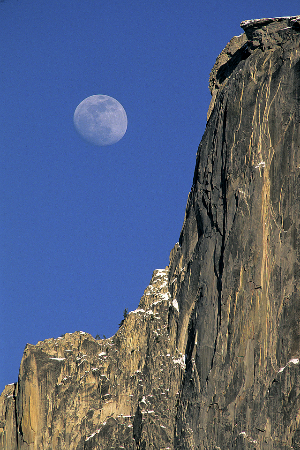Moonrise the Northwest Face of Half Dome
click on the image for a larger representation
Most of the time when I photograph I try to maintain a with a “go with the flow” approach. I like to walk outside with my camera, lenses, and tripod and just let the world come to me. That is: to just let whatever will be will be, and make my images accordingly. This particular photo was made using the exact opposite approach. This photograph was meticulously researched, planned, and then executed at the most favorable time.
One of the things I like to do is go out in Yosemite Valley about four days before the technical full moon and see where the moon is rising. This would give me an idea about how I might make a photograph with the moon in juxtaposition to some of the prominent monoliths or features in the valley. I had always had an idea to make a photo of a moonrise close to the face of Half Dome as the face of the dome was bathed in warm afternoon light. Once I determined that the moon was indeed going to be rising relatively close to the face of Half Dome, I set about to determine the exact location I could achieve the shot from. I knew I wanted to use a telephoto lens to make the moon appear as big as possible while allowing the viewer to be able to know without being told that it was Half Dome that was the landmark.
The only location that gave me precisely the setup I wanted was at a turnout on Southside drive near Curry Village in Yosemite Valley. From this location I was just able to get an unobstructed path to Half Dome and the place where I hoped the moon would be coming up. There are a lot trees in close proximity to where this was taken and I did not want any tree branches or other clutter in the image. I parked my truck in the turnout and set up my gear right at the edge of the road.
I started off with my 300mm lens set up on my largest, most sturdy tripod and anxiously waited for the moon to make its appearance. On the evenings prior to making this photograph I had noticed, that on every consecutive night, the moon successively moved to the south. I was very much hoping that I had not underestimated its movement and that it would not be behind Half Dome as it rose only to finally appear to me at the top of the dome instead of to the left where I desired it to be for the composition I had pre-envisioned.
I love the anticipation of these kinds of natural events and find more pleasure in them than most other experiences in life. The luminescent orb started to appear from behind the Northwest shoulder of Half Dome and the big event I had been waiting for began to materialize. The moon was going to rise almost exactly where I had hoped it would and I realized that all my planning had paid off. I started to frame the photo before the moon became fully revealed and I quickly realized that 300mm was not going to be enough lens in terms of rendering the moon at the size I wanted it to be, and how much landscape was in the image. In other words; I had too much information running through my frame.
Whenever I use my long telephoto lenses for landscape work I always use a separate, specialized brace that attaches to the camera body and then attaches to a
tripod leg. This gives two points of attachment for the camera and lens instead of the one usually associated and used with such setups. This allows the camera and lens to be as rock-solid as
possible minimizing vibrations that result in photographs not being as sharp and focused as is technically possible. I would also lay a custom made beanbag on top of the setup to further dampen
vibration and movement. The downside is that it is cumbersome to undo it all if and when I want to change to a longer lens or, as was the case in this situation, add a 1.4 teleconverter to give
me a 420mm lens and thereby give me a tighter, more succinct composition.
Time was of the essence as the moon was ascending quickly and I did not want to miss the opportunity to capture the moon in the exact position I desired. Once I got it all set up again I had to retighten the ball head, lock down the supplement clamp on the camera body, lay the beanbag on top of the lens, re-check the focus and make sure it was absolutely tack sharp. Then, I used the mirror lock-up function to eliminate the last vestiges of mechanical vibration, waited a few seconds for the vibration induced by me locking up the mirror to settle down, and then used a remote cable release to make the photograph.
This Photograph was made two days before the technical “full moon”. The sun is low in the South during the winter and the resulting warm light on Half Dome accentuates to perfection the right facing vertical corners on its face on the right side of the image. I made many images as the moon got higher and higher in the frame but the placement of it here ended up being the one I liked best as the moon fills all the dead blue space of the sky and allows it to shine supremely on its own as the wonder of nature that it is. The virtually full moon acts as a nice, heavenly counterpart to the warmly lit monolithic form of its eternally earthbound brethren.
Nikon F5 Film Camera
Tamron 300mm f2.8 lens with 1.4 teleconverter
Fuji Velvia 50 ISO slide film


